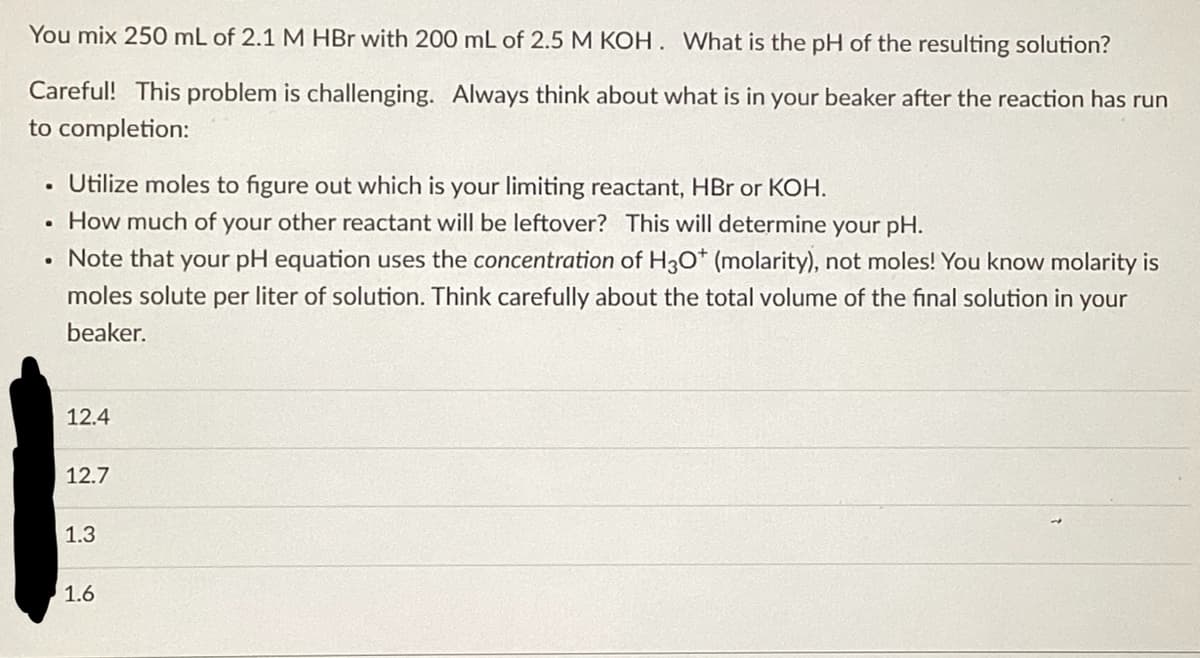You mix 250 mL of 2.1 M HBr with 200 mL of 2.5 M KOH. What is the pH of the resulting solution? Careful! This problem is challenging. Always think about what is in your beaker after the reaction has run to completion: Utilize moles to figure out which is your limiting reactant, HBr or KOH. • How much of your other reactant will be leftover? This will determine your pH. • Note that your pH equation uses the concentration of H3O* (molarity), not moles! You know molarity is moles solute per liter of solution. Think carefully about the total volume of the final solution in your beaker. . 1 12.4 12.7 1.3 1.6
You mix 250 mL of 2.1 M HBr with 200 mL of 2.5 M KOH. What is the pH of the resulting solution? Careful! This problem is challenging. Always think about what is in your beaker after the reaction has run to completion: Utilize moles to figure out which is your limiting reactant, HBr or KOH. • How much of your other reactant will be leftover? This will determine your pH. • Note that your pH equation uses the concentration of H3O* (molarity), not moles! You know molarity is moles solute per liter of solution. Think carefully about the total volume of the final solution in your beaker. . 1 12.4 12.7 1.3 1.6
Chemistry: Principles and Practice
3rd Edition
ISBN:9780534420123
Author:Daniel L. Reger, Scott R. Goode, David W. Ball, Edward Mercer
Publisher:Daniel L. Reger, Scott R. Goode, David W. Ball, Edward Mercer
Chapter16: Reactions Between Acids And Bases
Section: Chapter Questions
Problem 16.36QE
Related questions
Question
100%
Helppppppppl

Transcribed Image Text:You mix 250 mL of 2.1 M HBr with 200 mL of 2.5 M KOH. What is the pH of the resulting solution?
Careful! This problem is challenging. Always think about what is in your beaker after the reaction has run
to completion:
Utilize moles to figure out which is your limiting reactant, HBr or KOH.
• How much of your other reactant will be leftover? This will determine your pH.
• Note that your pH equation uses the concentration of H3O* (molarity), not moles! You know molarity is
moles solute per liter of solution. Think carefully about the total volume of the final solution in your
beaker.
.
1
12.4
12.7
1.3
1.6
Expert Solution
This question has been solved!
Explore an expertly crafted, step-by-step solution for a thorough understanding of key concepts.
This is a popular solution!
Trending now
This is a popular solution!
Step by step
Solved in 2 steps with 2 images

Knowledge Booster
Learn more about
Need a deep-dive on the concept behind this application? Look no further. Learn more about this topic, chemistry and related others by exploring similar questions and additional content below.Recommended textbooks for you

Chemistry: Principles and Practice
Chemistry
ISBN:
9780534420123
Author:
Daniel L. Reger, Scott R. Goode, David W. Ball, Edward Mercer
Publisher:
Cengage Learning

Chemistry & Chemical Reactivity
Chemistry
ISBN:
9781337399074
Author:
John C. Kotz, Paul M. Treichel, John Townsend, David Treichel
Publisher:
Cengage Learning

Chemistry & Chemical Reactivity
Chemistry
ISBN:
9781133949640
Author:
John C. Kotz, Paul M. Treichel, John Townsend, David Treichel
Publisher:
Cengage Learning

Chemistry: Principles and Practice
Chemistry
ISBN:
9780534420123
Author:
Daniel L. Reger, Scott R. Goode, David W. Ball, Edward Mercer
Publisher:
Cengage Learning

Chemistry & Chemical Reactivity
Chemistry
ISBN:
9781337399074
Author:
John C. Kotz, Paul M. Treichel, John Townsend, David Treichel
Publisher:
Cengage Learning

Chemistry & Chemical Reactivity
Chemistry
ISBN:
9781133949640
Author:
John C. Kotz, Paul M. Treichel, John Townsend, David Treichel
Publisher:
Cengage Learning

Principles of Modern Chemistry
Chemistry
ISBN:
9781305079113
Author:
David W. Oxtoby, H. Pat Gillis, Laurie J. Butler
Publisher:
Cengage Learning

General Chemistry - Standalone book (MindTap Cour…
Chemistry
ISBN:
9781305580343
Author:
Steven D. Gammon, Ebbing, Darrell Ebbing, Steven D., Darrell; Gammon, Darrell Ebbing; Steven D. Gammon, Darrell D.; Gammon, Ebbing; Steven D. Gammon; Darrell
Publisher:
Cengage Learning

Chemistry: An Atoms First Approach
Chemistry
ISBN:
9781305079243
Author:
Steven S. Zumdahl, Susan A. Zumdahl
Publisher:
Cengage Learning